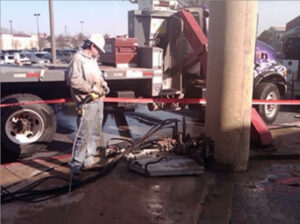Concrete structures need to remain sturdy, and you can get them to last a very long time with proper care. Unfortunately, some factors can negatively impact concrete structures. One of those factors is water. If concrete structures take on too much water, they won’t be nearly as strong, and they won’t last nearly as long. We’ve discussed how water can harm concrete before, but there are still other manners in which water can cause problems. Here are more of the ways that concrete structures can be compromised by water.
Carbonation
New types of concrete will have reinforced steel in them that provides sufficient protection against corrosion. This is because there is free lime inside of new concrete, which makes an environment high in alkaline. This makes what’s known as a “passivating” layer, which is created around the bars.
The passivating layer supplies protection from corrosion and oxidation. As time passes, carbon dioxide in the atmosphere turns free lime into limestone until it reaches deep inside reinforced steel.
Because the pH level of carbonated concrete is low, it will cause the passivating layer to break down, and when oxygen and water start to affect the concrete, the iron will oxidize and form rust. Rust has a greater overall volume, which makes concrete structures expand until they begin to crack. Cracking accelerates the process of deteriorating and corroding.
Chloride Attacks
Whenever there are chloride ions around, concrete structures can be easily compromised. Chlorides are able to destabilize steel’s passive protective layer, and once this layer has been removed, the corroding process can start.
You should be warier of chloride attacks if your concrete structures are near roads with de-icing salts on them or if they are close to ocean water.
Sulfate Attacks
Sulfate can either damage your concrete physically or chemically. Sulfate is able to alter the chemical structure of the concrete, resulting in the aggregate and cement paste having a weaker bond holding them together. This can cause wear and cracking to occur.
Your concrete structures can also be damaged through the crystallizing and re-crystallizing processes. This causes expansion and cracking in your concrete.
Concrete Visions Will Get The Job Done Right
Concrete Visions has been working with clients for over 25 years. Our G&M Services installers are certified with the industry’s major firestop product manufacturers. As part of our firestop service, we can assess abnormal field conditions and, with the manufacturer’s technical support assistance, provide engineering judgments in a timely fashion to comply with contract specifications. Our Field Mechanics undergo ongoing training, including mandatory monthly safety meetings, weekly Toolbox Talks where safety and equipment information is shred, and trainings on safe work standards and safety best practices.

